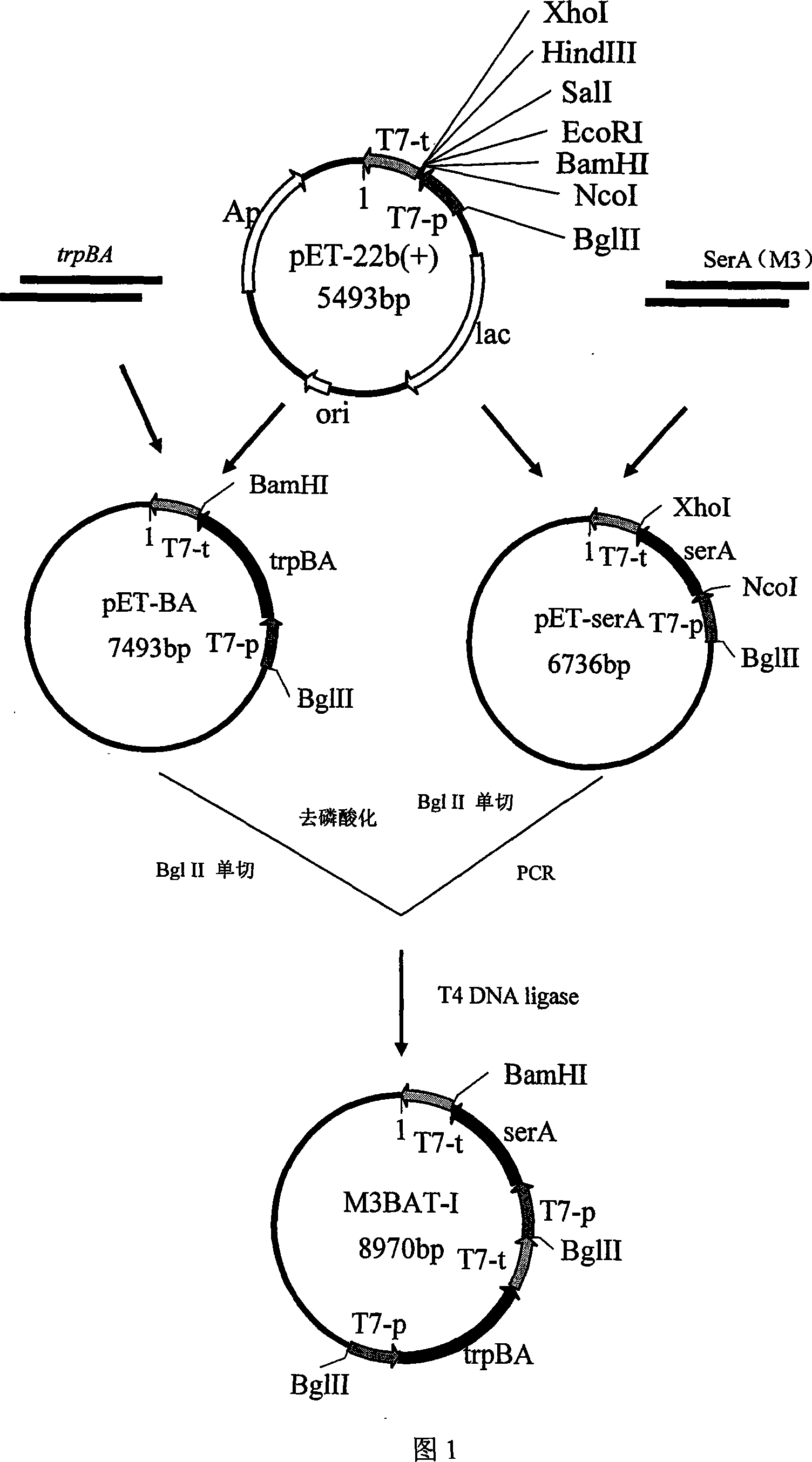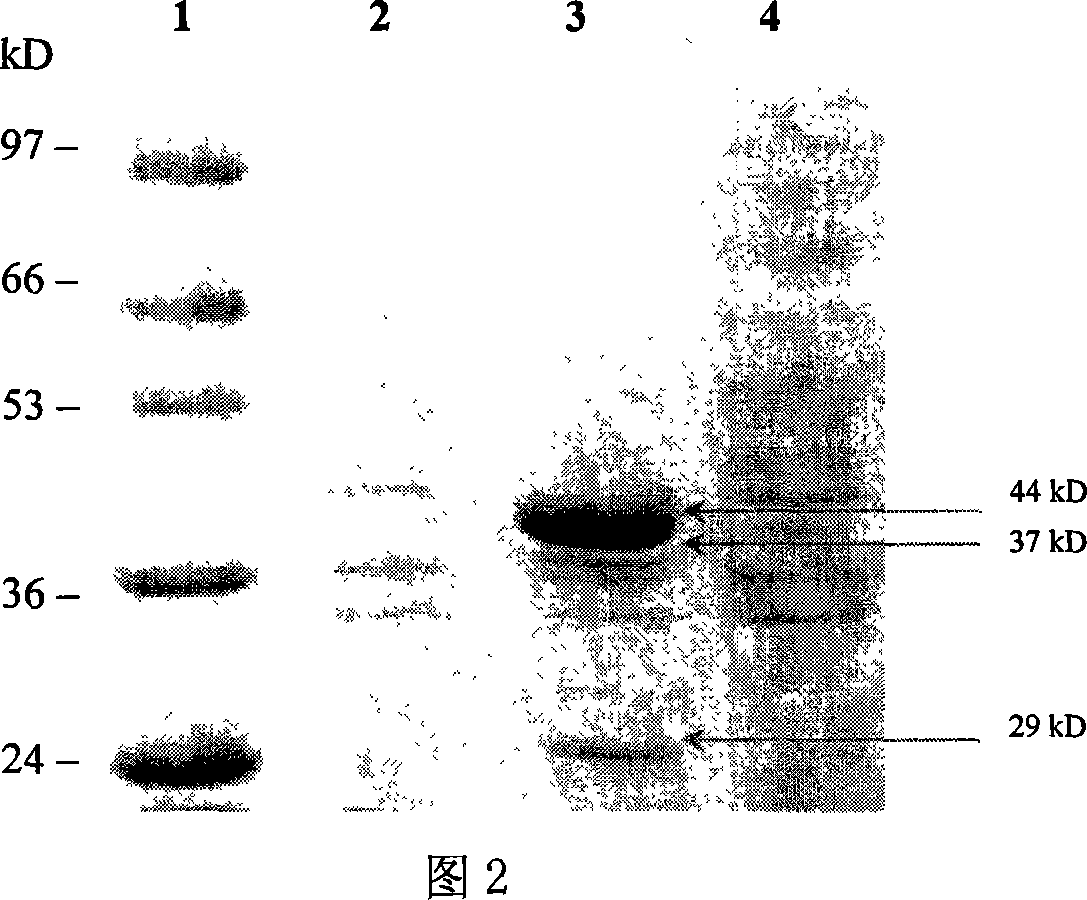Gene engineering bacterium for strengthening metabolic pathway of synthesizing tryptophan
A technology of genetically engineered bacteria and tryptophan synthase, applied in genetic engineering, plant genetic improvement, bacteria, etc.
- Summary
- Abstract
- Description
- Claims
- Application Information
AI Technical Summary
Problems solved by technology
Method used
Image
Examples
Embodiment 1
[0025] A recombinant plasmid containing a mutant of tryptophan synthase gene and phosphoglycerate dehydrogenase gene is prepared by the following method: using pET22b (+) single plasmid multi-gene tandem expression strategy to synthesize tryptophan The enzyme gene trpBA gene was concatenated with the phosphoglycerate dehydrogenase gene mutant M3serA gene to obtain a recombinant plasmid pET-T7 promoter-M3serA-T7promotor-trpBA-T7 terminator, which was named M3BAT-I. The construction process is shown in Figure 1.
[0026] The construction method of the serA gene mutant (M3serA gene) has been published in "Chinese Journal of Biochemistry and Molecular Biology" 2006, No. 10, pages 806-810.
[0027] The method for cloning the trpBA gene has been published on pages 12-14 of the first issue of "Biotechnology Letters" in 2006.
Embodiment 2
[0029] A genetically engineered bacterium with enhanced tryptophan synthesis and metabolism pathway is obtained by the following method: Infect the host bacterium Escherichisa coli 491 with λDE3 phage, and make the chromosome of the lysogenized bacterium named DE3-491 contain a Copy the T7 RNA polymerase gene controlled by lacUV5, and transfer a recombinant plasmid M3BAT-I containing tryptophan synthase gene and phosphoglycerate dehydrogenase gene mutant made in Example 1 into competent DE3-491 Afterwards, it became a genetically engineered bacterium named M3BAT-I+DE3-491 with enhanced tryptophan synthesis and metabolism pathway. Induced expression with IPTG, analyzed by SDS-PAGE, M3BAT-I can express 44kD, 37kD, 29kD proteins in DE3-491 (Figure 2), which correspond to tryptophan synthase β subunit and phosphoglycerate dehydrogenase M3 respectively Mutant, tryptophan synthase alpha subunit. Enzyme activity analysis showed that the activity of tryptophan synthetase was increase...
Embodiment 3
[0031] A kind of genetically engineered bacterium that knocks out the tryptophan synthetic metabolic pathway of tnaA gene and strengthens is obtained by the following method: (1) selecting tnaA gene upstream and downstream flanking sequence fragments and kanamycin resistance gene kan r , connected to construct the tandem gene cassette pET22b-tnaA5'-kan r -tnaA3', and the linearized fragment tnaA5'-kan r -tnaA3' replaces the tnaA gene on the chromosome of a genetically engineered bacterium (M3BAT-I+DE3-491) with enhanced tryptophan synthesis and metabolism pathway through the Red homologous recombination system, resulting in the loss of the normal function of the gene and obtaining tryptophan The acidase-deficient strain was named M3BAT-I+DE3-491ΔT.
[0032] PCR amplification (Figure 4) and sequence determination (Figure 5) confirmed that the tnaA gene had been successfully knocked out.
PUM
 Login to View More
Login to View More Abstract
Description
Claims
Application Information
 Login to View More
Login to View More - R&D
- Intellectual Property
- Life Sciences
- Materials
- Tech Scout
- Unparalleled Data Quality
- Higher Quality Content
- 60% Fewer Hallucinations
Browse by: Latest US Patents, China's latest patents, Technical Efficacy Thesaurus, Application Domain, Technology Topic, Popular Technical Reports.
© 2025 PatSnap. All rights reserved.Legal|Privacy policy|Modern Slavery Act Transparency Statement|Sitemap|About US| Contact US: help@patsnap.com



